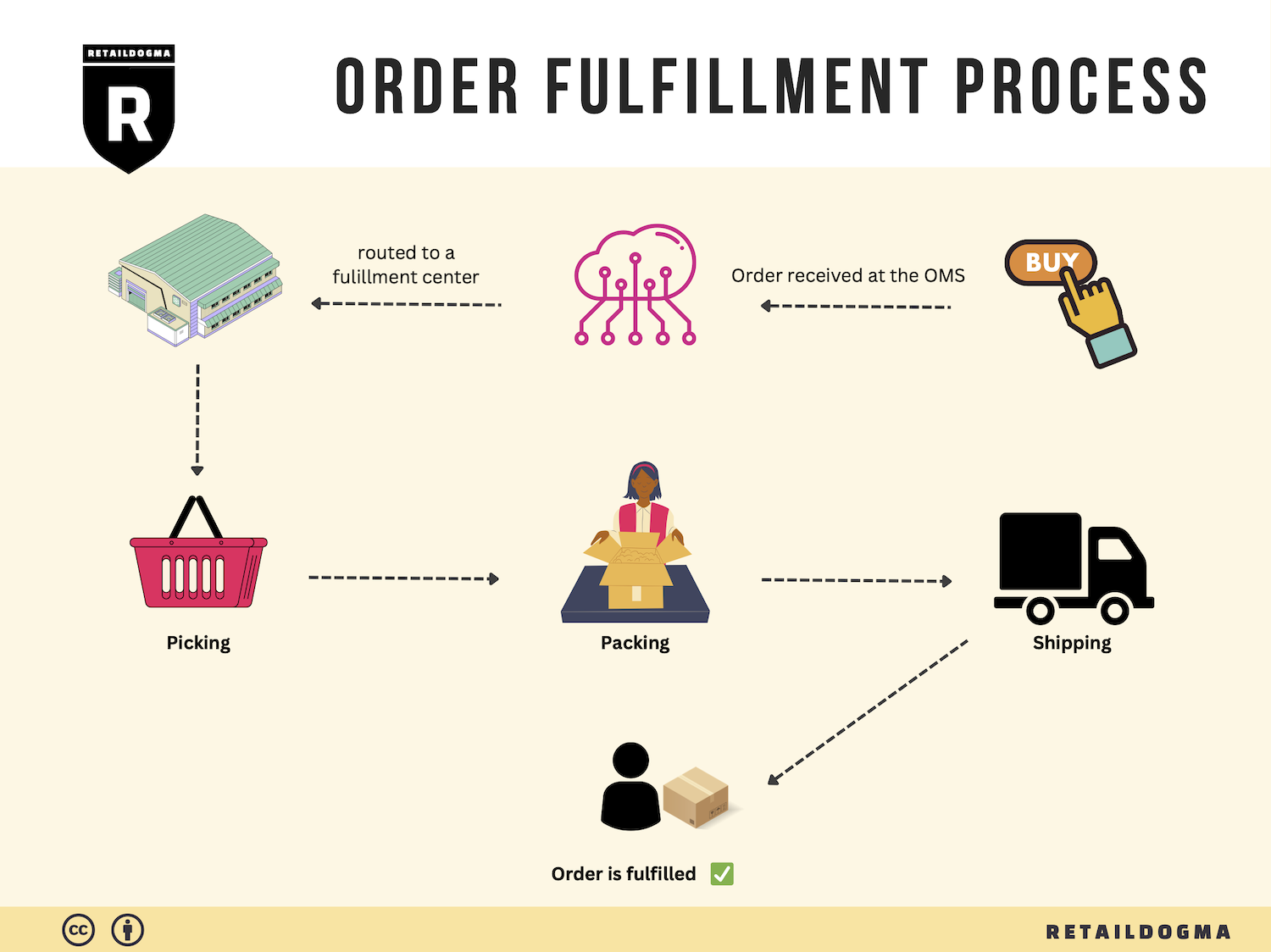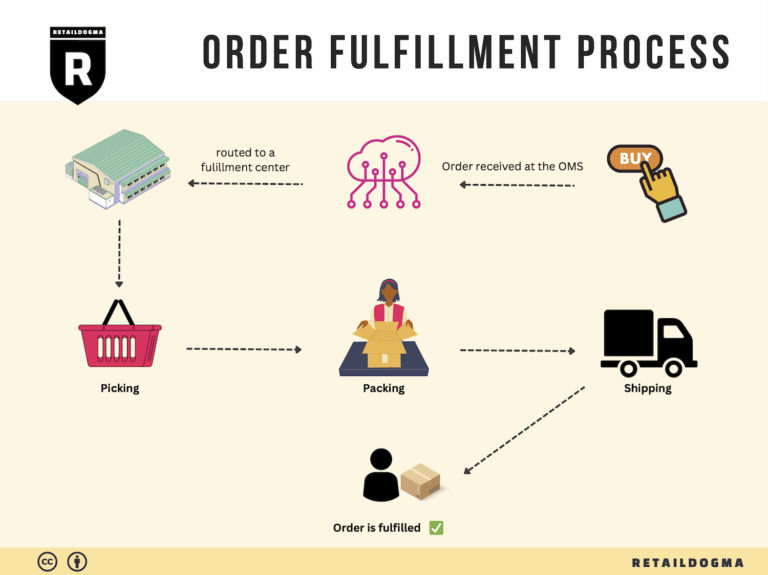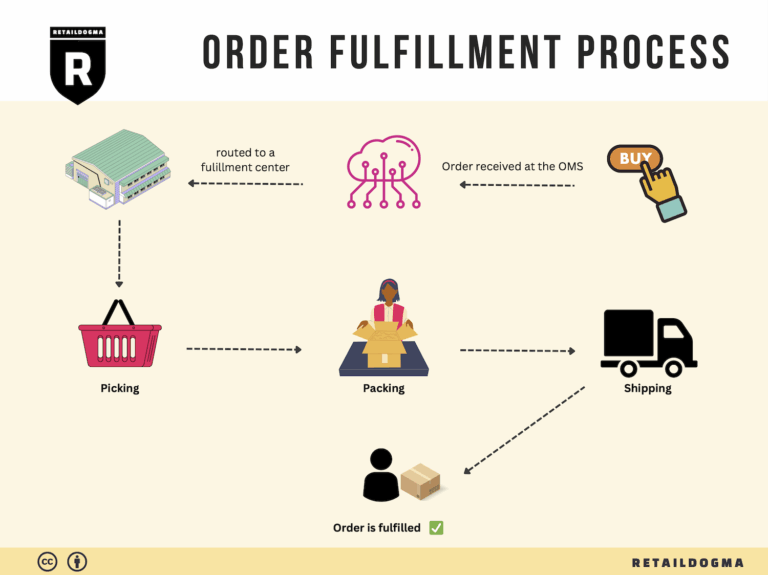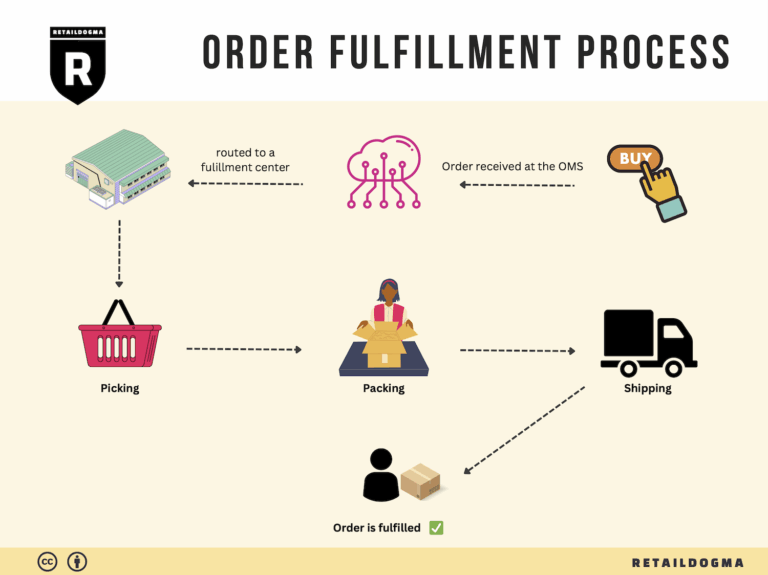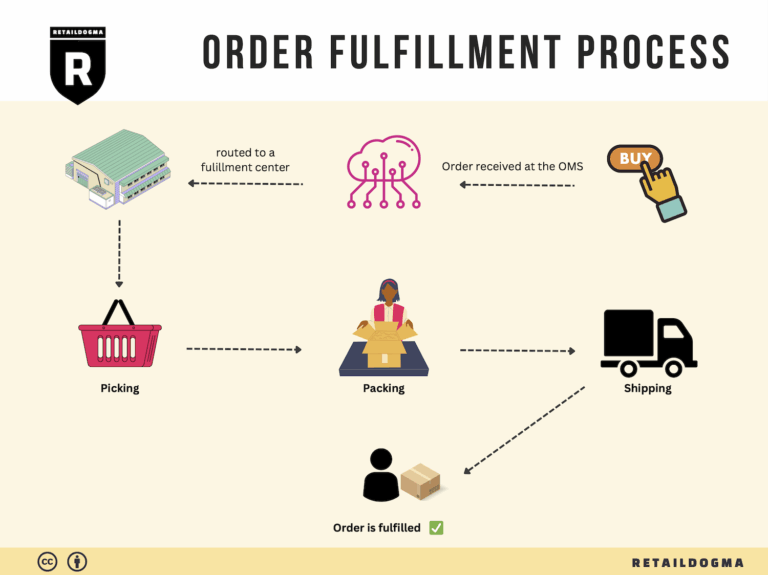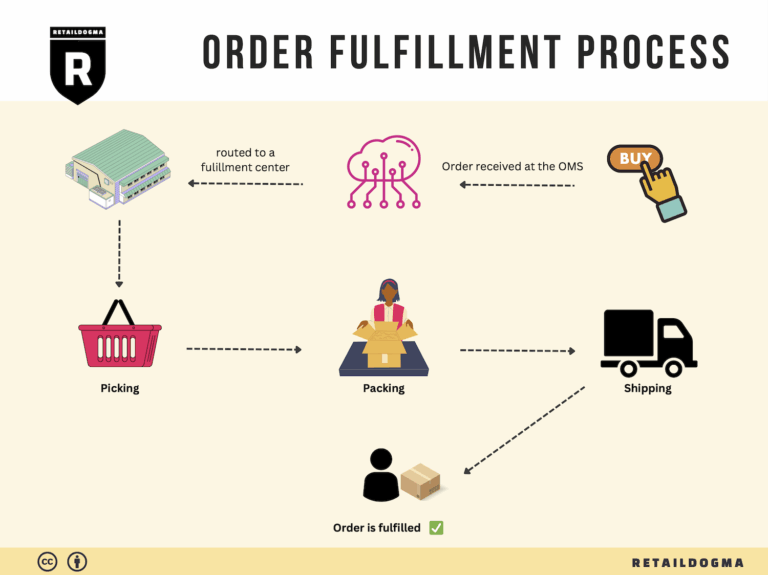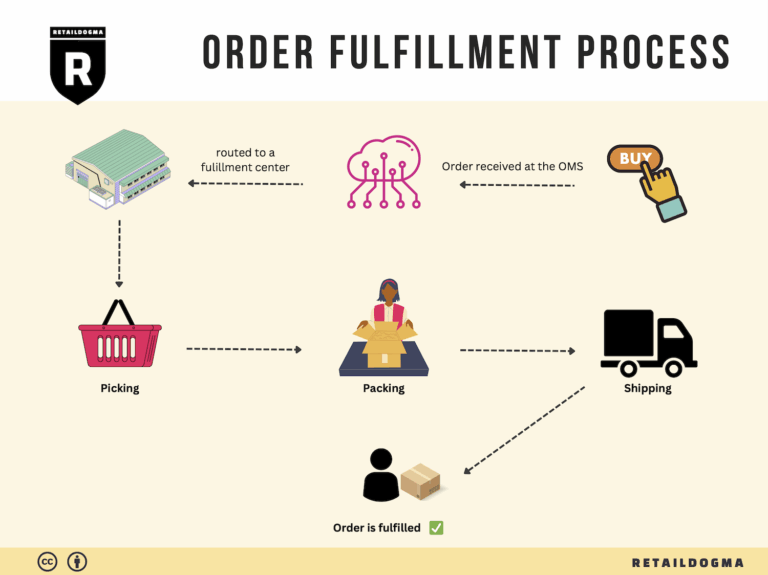How Order Fulfillment Works: A Step-by-Step Guide for Businesses
What is E-commerce Fulfillment? An Introduction for Growing Businesses
Understanding E-commerce Fulfillment
As an e-commerce business owner, you may find yourself grappling with a common challenge: the overwhelming demands of packing and shipping orders. Managing these logistics can quickly become a time-consuming task that diverts your focus from growing your business. To put it simply, e-commerce fulfillment is the process of getting a product from your inventory to your customer’s doorstep. It encompasses everything from inventory management and order processing to packaging and shipping.
In today’s competitive landscape, efficient fulfillment is crucial for customer satisfaction and repeat business. This guide aims to demystify the various aspects of e-commerce fulfillment, helping you navigate the complexities of logistics as you scale your operations.
What You’ll Learn
In this guide, we will explore several fulfillment models that can suit your business needs, including Third-Party Logistics (3PL) and Fulfillment by Amazon (FBA). Each model offers distinct advantages depending on your business size, product type, and customer base. Understanding these options will empower you to choose the best path for your business.
We will also delve into the core services offered by fulfillment centers. These services typically include inventory receiving, storage, order processing, picking, packing, and shipping. Knowing what to expect can help you streamline your operations and enhance your customer experience.
Choosing the right fulfillment partner is another critical component of your logistics strategy. We will discuss key factors to consider, such as reliability, technology integration, and scalability. A well-chosen partner can significantly impact your operational efficiency and overall success.
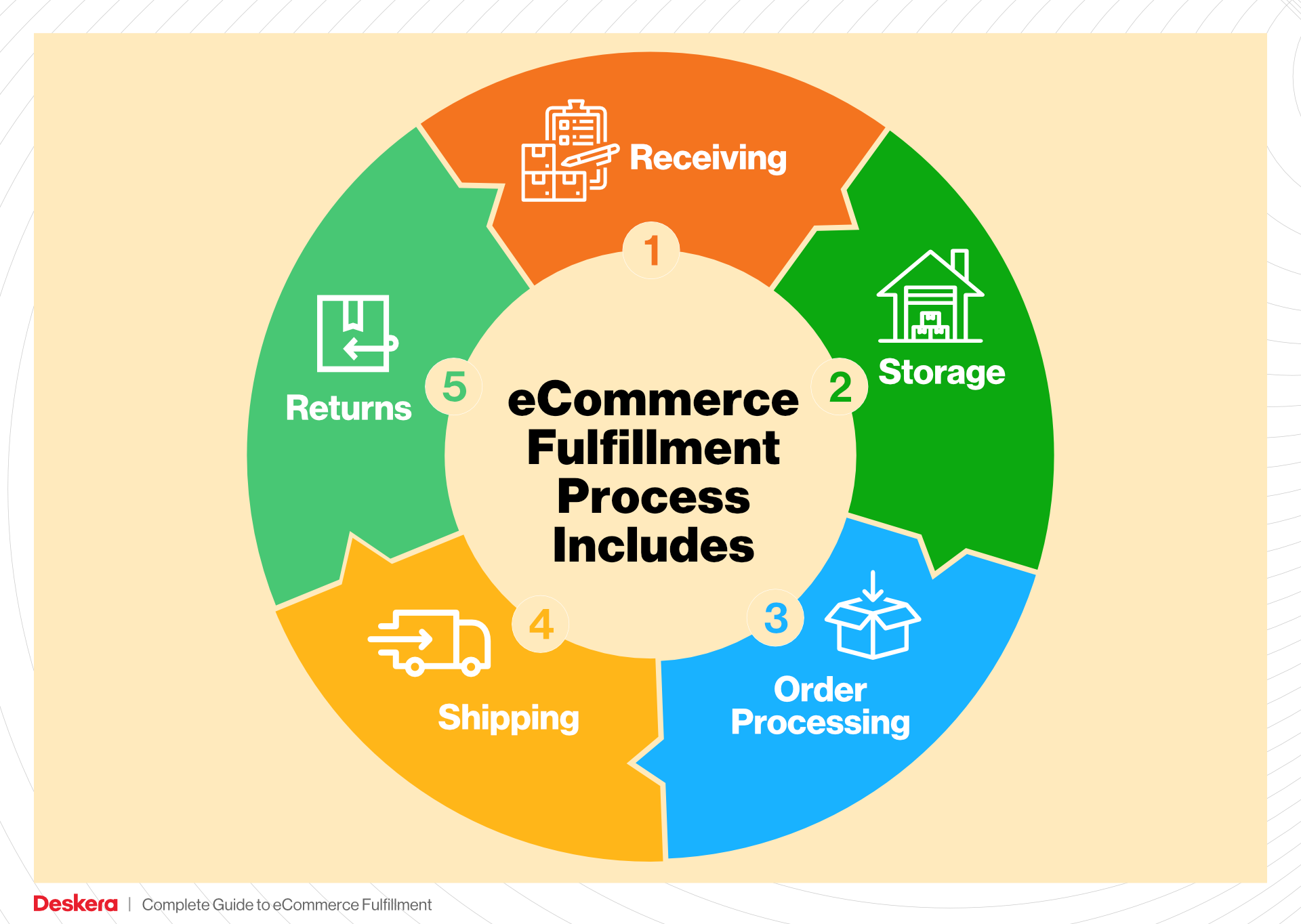
Finally, pricing models in e-commerce fulfillment can be complex. We will break down common pricing structures to help you understand how costs are calculated, enabling you to make informed decisions about your logistics budget.
Goal of This Guide
Our primary goal is to empower you to make smart, strategic decisions about your e-commerce fulfillment logistics. By providing you with practical insights and expert advice, we aim to help you optimize your operations and ultimately drive growth. Whether you’re just starting or looking to refine your existing processes, this guide will serve as a valuable resource in your journey toward efficient and effective fulfillment.
What You’ll Learn In This Guide
- What is E-commerce Fulfillment? An Introduction for Growing Businesses
- The Order Fulfillment Process: From ‘Buy’ Button to Customer’s Door
- Comparing Fulfillment Models: In-House vs. 3PL vs. Dropshipping
- A Deep Dive into Amazon FBA: Pros, Cons, and Who It’s For
- Core Services Offered by Fulfillment Centers
- How to Choose a Fulfillment Partner: A 6-Point Checklist
- Understanding Fulfillment Pricing: A Breakdown of Common Fees
- Frequently Asked Questions (FAQs) about Fulfillment
- Conclusion: Is Outsourcing Fulfillment the Right Move for Your Business?
- Important Disclaimer
The Order Fulfillment Process: From ‘Buy’ Button to Customer’s Door
1. Receiving Inventory
The first step in the order fulfillment process is the receiving inventory phase. When products arrive at an Amazon fulfillment center, they are unloaded from delivery trucks and checked for accuracy against shipping manifests. This process is crucial because it ensures that the correct items have been delivered and that they meet quality standards.
Key to this step is the use of Stock Keeping Units (SKUs), which are unique identifiers assigned to each product. By scanning SKUs upon arrival, warehouse staff can efficiently track inventory levels and manage stock. This initial verification not only helps in preventing discrepancies but also sets the stage for effective inventory management throughout the fulfillment process.
2. Warehouse Storage
Once the inventory has been received and verified, it moves to the warehouse storage phase. Here, items are organized within the fulfillment center, typically using a combination of automated systems and human labor. Products may be stored based on various criteria, such as size, type, or demand frequency, which enhances retrieval efficiency.
This step is vital because proper storage practices can significantly reduce the time taken for subsequent processes. Amazon utilizes barcode scanning technology to track the location of each item, allowing for real-time updates to inventory records. This not only aids in efficient stock management but also minimizes the risk of stockouts and overstock situations, which can impact sales and customer satisfaction.
3. Order Picking
The next phase is order picking, where items are retrieved from storage to fulfill customer orders. When a customer places an order, the fulfillment center generates a pick list—a document that outlines the items to be collected, including their locations within the warehouse. This list is crucial for guiding pickers through the warehouse efficiently.
In Amazon fulfillment centers, this process is often supported by technology, including automated systems and robots that assist human pickers. Efficient order picking is essential, as it directly affects the speed of order fulfillment and, ultimately, customer satisfaction. An accurate and swift picking process reduces the chances of errors, ensuring that the right items are delivered to the customer.
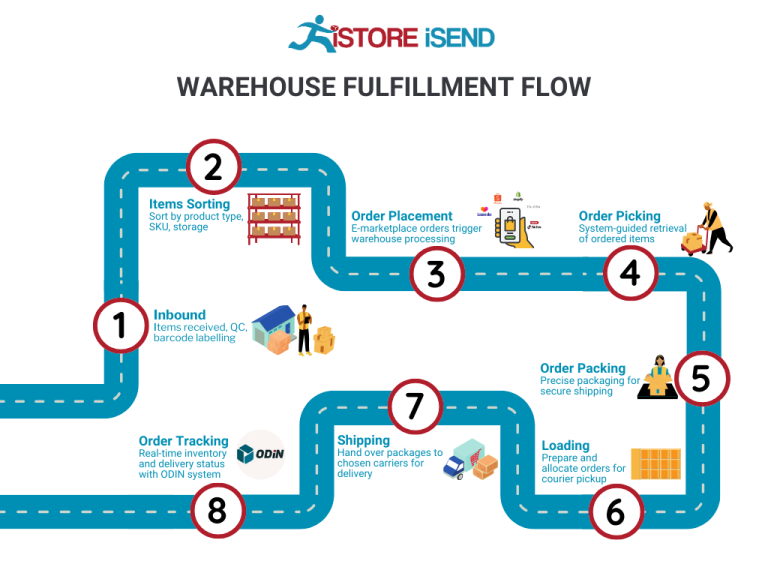
4. Order Packing
Once the items are picked, they move to the order packing phase. In this step, products are carefully packed into boxes or other shipping containers, with attention paid to ensuring they are secure and protected during transit. The packing process includes generating shipping labels and packing slips, which provide essential information for both logistics and the customer.
This step is critical because it not only protects the products but also reflects the brand’s commitment to quality. Using packing materials that are appropriate for the items being shipped helps minimize damage during transport and can enhance the unboxing experience for the customer. A well-packed order reduces the likelihood of returns due to damage, which can be costly for businesses.
5. Shipping & Delivery
The final step in the order fulfillment process is shipping and delivery. Once packed, orders are dispatched from the fulfillment center to various destinations. Amazon employs a vast network of carriers and logistics partners to ensure timely delivery, often utilizing advanced routing algorithms to optimize delivery routes.
This phase is essential as it directly impacts customer satisfaction. Fast and reliable shipping is a key differentiator in e-commerce, and Amazon’s commitment to quick delivery has set industry standards. The term Last Mile Delivery is particularly relevant here, referring to the final step of the delivery process when the package reaches the customer’s doorstep. Efficient last-mile delivery can significantly enhance customer loyalty and repeat purchases.
By understanding and optimizing each step of the order fulfillment process, e-commerce businesses can not only enhance operational efficiency but also improve customer satisfaction, ultimately leading to increased sales and growth.
Comparing Fulfillment Models: In-House vs. 3PL vs. Dropshipping
Fulfillment Models Comparison
| Model | Who Handles Inventory | Best For (Business Stage) | Key Advantage | Key Disadvantage |
|---|---|---|---|---|
| In-House Fulfillment | The business itself | Startups to established businesses | Full control over operations | High overhead and fixed costs |
| Third-Party Logistics (3PL) | A third-party logistics provider | Growing businesses | Scalability and flexibility | Less control over fulfillment |
| Dropshipping | Suppliers or manufacturers | Startups and entrepreneurs | Low startup costs and risk | Lower profit margins and control |
In-House Fulfillment
In-house fulfillment refers to a model where a business manages its own inventory and order fulfillment processes. This typically involves maintaining a warehouse, hiring staff for inventory management, order picking, packing, and shipping. In-house fulfillment can be beneficial for businesses that require a high degree of control over their inventory and customer experience. This model is particularly advantageous for established companies that have stable sales volumes and can afford the overhead costs associated with running a warehouse and hiring employees. The key advantage of in-house fulfillment is the ability to customize operations, ensuring that the fulfillment process aligns closely with brand values and customer expectations. However, the downside includes high fixed costs, such as rent, utilities, and labor, which can strain cash flow, especially for smaller or emerging businesses.
Third-Party Logistics (3PL)
Third-party logistics (3PL) involves outsourcing fulfillment operations to a specialized logistics provider. This model allows businesses to focus on core competencies like marketing and product development while leveraging the expertise and infrastructure of a 3PL provider. This arrangement is ideal for growing businesses that experience fluctuating order volumes and need the flexibility to scale operations up or down based on demand. The major advantage of using a 3PL is the ability to quickly adapt to market changes and take advantage of the provider’s established logistics networks, potentially reducing shipping times and costs. However, a significant drawback is the reduced control over the fulfillment process, which may impact customer service if the 3PL does not meet the business’s standards or expectations.
Dropshipping
Dropshipping is a fulfillment model where the retailer does not hold any inventory. Instead, when a customer places an order, the retailer purchases the item from a third party, usually a supplier or manufacturer, who then ships it directly to the customer. This model is particularly appealing for startups and entrepreneurs, as it requires minimal upfront investment and eliminates the risks associated with holding inventory. The key advantage of dropshipping is the low barrier to entry, allowing businesses to offer a wide range of products without the overhead costs of warehousing and inventory management. However, this model also comes with significant disadvantages, including lower profit margins and limited control over product quality and shipping times. Additionally, reliance on suppliers for fulfillment can lead to issues if they fail to meet customer expectations, which can damage the retailer’s reputation.
Conclusion
Choosing the right fulfillment model is crucial for any e-commerce business, as it directly impacts operational efficiency, customer satisfaction, and overall profitability. Each model—whether in-house fulfillment, third-party logistics, or dropshipping—offers unique advantages and challenges. Businesses must assess their specific needs, resources, and growth strategies when deciding which fulfillment approach aligns best with their objectives. By understanding the nuances of each model, e-commerce business owners can make informed decisions that will facilitate growth and enhance customer experiences.
A Deep Dive into Amazon FBA: Pros, Cons, and Who It’s For
Understanding Fulfillment by Amazon (FBA)
Fulfillment by Amazon (FBA) is a service that allows e-commerce sellers to store their products in Amazon’s fulfillment centers. This service takes care of storage, packaging, and shipping, enabling sellers to leverage Amazon’s extensive logistics network. By using FBA, sellers can ensure that their products are eligible for Amazon Prime, benefiting from faster shipping options that appeal to a vast customer base.
How FBA Works
-
Setup: Sellers create an Amazon seller account and enroll in the FBA program. They then prepare their products according to Amazon’s guidelines, ensuring proper labeling and packaging.
-
Shipping Inventory: Once the products are ready, sellers ship their inventory directly to Amazon’s fulfillment centers. Amazon has numerous centers across the globe, which allows for efficient storage and distribution.
-
Storage: Amazon stores the products in its warehouses until an order is placed. The inventory is organized and tracked using advanced technology, including barcode scanning systems.
-
Order Processing: When a customer places an order, Amazon takes care of the picking, packing, and shipping of the product. This process is automated and optimized to ensure quick delivery.
-
Customer Service and Returns: Amazon also handles customer service inquiries and returns for FBA products, simplifying the seller’s workload significantly.

Pros of Fulfillment by Amazon
1. Prime Eligibility
One of the most significant advantages of using FBA is that products become eligible for Amazon Prime. This status can greatly increase visibility and sales, as Prime members prefer products that offer fast and free shipping.
2. Customer Trust
Amazon is a trusted brand, and customers often feel more comfortable purchasing products fulfilled by Amazon. The FBA program enhances credibility, as it signals to buyers that their orders will be handled efficiently and reliably.
3. Multi-Channel Fulfillment
FBA isn’t limited to sales made on Amazon. Sellers can utilize FBA for orders made through other channels, such as their own websites or other marketplaces. This multi-channel fulfillment capability allows for a streamlined logistics process across various sales platforms.
4. Efficient Shipping
With FBA, sellers benefit from Amazon’s extensive logistics network, which can handle shipping and delivery more efficiently than many small businesses can manage on their own. This efficiency can lead to faster delivery times and improved customer satisfaction.
5. Scalable Solution
FBA allows sellers to scale their business without needing to invest heavily in warehousing, staff, or shipping logistics. As sales increase, sellers can simply send more inventory to Amazon.
Cons of Fulfillment by Amazon
1. High Fees
While FBA offers many benefits, it also comes with costs. Sellers incur various fees, including storage fees for keeping products in Amazon’s warehouses and fulfillment fees for each order processed. These costs can add up quickly, potentially eating into profit margins.
2. Strict Inventory Rules
Amazon has stringent inventory management policies that sellers must follow. This includes rules regarding product preparation, labeling, and packaging. Failure to comply with these standards can lead to additional fees or even account suspension.
3. Commingling Risks
With FBA, sellers’ inventory may be mixed with products from other sellers, known as commingling. This practice can lead to concerns regarding product quality and authenticity. If a customer receives a defective item from another seller, it could negatively impact the original seller’s reputation.
4. Limited Control Over Fulfillment
Sellers relinquish control over the fulfillment process to Amazon. This means they cannot customize packaging or delivery options, which can be a drawback for those wanting to maintain a specific brand image.
5. Inventory Management Challenges
Managing inventory levels can be more complex with FBA. Sellers must anticipate demand accurately, as overstocking can lead to high storage fees, while understocking can result in lost sales and reduced visibility.
Who is FBA Best For?
Fulfillment by Amazon is particularly beneficial for:
-
E-commerce Entrepreneurs: Those looking to expand their reach without the overhead of managing logistics can leverage FBA to scale their business efficiently.
-
Small to Medium-Sized Businesses: Businesses that may not have the resources to handle warehousing and shipping can utilize FBA to access Amazon’s logistics capabilities.
-
Sellers with High Sales Volume: Businesses that anticipate high sales volumes can benefit from FBA’s fast and efficient fulfillment processes.
-
Brands Seeking Credibility: New sellers or lesser-known brands can gain customer trust by using Amazon’s fulfillment network, which is associated with reliability and efficiency.
-
Multi-Channel Sellers: Businesses that sell across various platforms can centralize their fulfillment process through FBA, simplifying logistics and inventory management.
In conclusion, while FBA offers numerous advantages, including access to Amazon’s vast customer base and logistical expertise, it is essential for sellers to weigh these benefits against the potential downsides, such as fees and inventory control challenges. By understanding the full scope of FBA, e-commerce business owners can make informed decisions that align with their operational goals and growth strategies.
Core Services Offered by Fulfillment Centers
Inventory Management & Warehousing
Inventory management and warehousing form the backbone of fulfillment centers, allowing e-commerce businesses to efficiently store and manage their products. This service involves receiving inventory, organizing it within the warehouse, and ensuring that stock levels are accurately tracked.
Fulfillment centers utilize advanced inventory management systems that integrate with e-commerce platforms to provide real-time visibility into stock levels. This means businesses can avoid overstocking or stockouts, both of which can significantly affect sales and customer satisfaction.
The benefits of effective inventory management include reduced carrying costs, improved cash flow, and enhanced operational efficiency. By outsourcing warehousing to a fulfillment center, e-commerce businesses can free up valuable space and resources, allowing them to focus on other critical areas such as marketing and customer engagement. Additionally, accurate inventory tracking minimizes the risk of errors in order fulfillment, fostering trust and loyalty among customers.
Pick and Pack Services
Pick and pack services are central to the order fulfillment process in fulfillment centers. When a customer places an order, fulfillment centers are responsible for “picking” the correct items from their inventory and then “packing” them for shipment. This process is often streamlined through the use of technology, such as barcode scanning and automated picking systems.
For e-commerce businesses, the advantages of efficient pick and pack services are substantial. Fast and accurate order fulfillment leads to shorter delivery times, which is a crucial factor for customer satisfaction in today’s competitive market. Furthermore, well-organized packing processes reduce the likelihood of shipping errors, which can be costly in terms of returns and customer dissatisfaction.
Fulfillment centers often employ best practices in packing, including the use of appropriate materials to protect products during transit. This attention to detail not only enhances the customer experience but also reduces the risk of damage, thereby lowering return rates.
Kitting and Assembly
Kitting and assembly services offered by fulfillment centers allow e-commerce businesses to create bundled products or prepare items for sale that require assembly. Kitting involves grouping individual items together as a single unit, while assembly refers to the process of putting together components to create a finished product.
These services are especially beneficial for businesses that sell complex products or those that offer promotional bundles. By outsourcing kitting and assembly to a fulfillment center, e-commerce businesses can streamline their operations and reduce the time and labor involved in preparing products for sale.
The primary advantages of kitting and assembly services include improved operational efficiency and enhanced customer satisfaction. Bundled products often attract more buyers, as they offer perceived value, and well-assembled items are more appealing to customers. By leveraging these services, businesses can also optimize their inventory management, as they can consolidate multiple SKUs into a single kit, simplifying storage and tracking.
Returns Management (Reverse Logistics)
Returns management, or reverse logistics, is a critical service provided by fulfillment centers that focuses on processing returned items efficiently. This includes receiving returned merchandise, inspecting it, restocking it, or processing it for repair or disposal.
For e-commerce businesses, effective returns management can significantly impact customer loyalty and overall operational efficiency. A smooth returns process enhances the customer experience, as buyers are more likely to make a purchase if they know they can return items easily. Fulfillment centers can implement automated systems to streamline the returns process, allowing businesses to quickly assess the condition of returned items and determine the appropriate next steps.
Additionally, efficient returns management can help businesses recover value from returned products, either by restocking them for resale or by refurbishing them when possible. This not only mitigates losses associated with returns but also contributes to sustainability efforts by minimizing waste.
In conclusion, fulfillment centers offer a suite of core services that can significantly benefit e-commerce businesses looking to scale their operations. By leveraging inventory management, pick and pack services, kitting and assembly, and returns management, businesses can enhance their operational efficiency, improve customer satisfaction, and ultimately drive sales growth. Outsourcing these critical functions allows e-commerce entrepreneurs to focus on their core competencies while ensuring that their logistics operations are handled by experts in the field.
How to Choose a Fulfillment Partner: A 6-Point Checklist
Location & Warehouse Network
Importance:
The geographical location of your fulfillment partner is crucial for shipping efficiency and cost-effectiveness. A partner with a well-distributed network of warehouses can reduce shipping times and costs, enhancing customer satisfaction.
Questions to Ask:
– Where are your warehouses located, and how many do you operate?
– Can you provide coverage maps showing your service areas?
– How do you determine which warehouse will fulfill an order?
Technology & Integrations
Importance:
In today’s digital age, the technology used by your fulfillment partner can significantly impact your operations. Robust technology systems ensure smooth order processing, inventory management, and real-time tracking, which are essential for maintaining operational efficiency and transparency.
Questions to Ask:
– What software platforms do you use for inventory management and order fulfillment?
– How do you integrate with e-commerce platforms like Shopify, Amazon, or WooCommerce?
– Can you provide real-time tracking for orders, and how is this communicated to customers?
Specializations (e.g., Cold Storage, Oversized Items)
Importance:
Not all fulfillment partners are equipped to handle every type of product. Understanding your product requirements is essential. If you deal in perishable goods, oversized items, or require special handling, ensure your partner has the necessary capabilities.
Questions to Ask:
– Do you have specialized facilities for handling temperature-sensitive items?
– How do you manage oversized or heavy items in your inventory?
– What processes are in place for handling fragile or high-value items?
Scalability & Capacity
Importance:
As your business grows, your fulfillment needs will evolve. It’s vital to choose a partner that can scale with your business, whether it’s during peak seasons or as you expand into new markets.
Questions to Ask:
– What is your current capacity, and how do you manage peak demand periods?
– Can you accommodate seasonal fluctuations in order volume?
– What steps do you take to ensure consistent service during rapid growth phases?
Pricing and Contracts
Importance:
Understanding the pricing structure and contract terms is essential for budgeting and financial planning. A transparent pricing model helps avoid unexpected costs and ensures you get the best value for your investment.
Questions to Ask:
– Can you provide a detailed breakdown of your pricing structure, including any hidden fees?
– What are the terms of your contract, and how flexible are they?
– Do you offer volume discounts or incentives for long-term partnerships?
Customer Support & Reviews
Importance:
Effective customer support is crucial for resolving issues quickly and maintaining smooth operations. Additionally, researching reviews and testimonials can provide insights into the partner’s reliability and service quality.
Questions to Ask:
– What customer support channels do you offer (e.g., phone, email, chat)?
– Can you provide references from current or past clients?
– How do you handle issues such as shipping errors or inventory discrepancies?
Conclusion
Choosing the right fulfillment partner is a strategic decision that can significantly impact your e-commerce business’s success. By carefully evaluating potential partners using this checklist, you can ensure that you select a fulfillment partner that aligns with your operational needs and growth objectives. Remember, the right partner will not only enhance your logistics capabilities but also contribute to a positive customer experience.
Understanding Fulfillment Pricing: A Breakdown of Common Fees
Initial Setup Fees
When engaging with a fulfillment center like Amazon’s AVP1, businesses often encounter initial setup fees. These fees are charged to establish your account and prepare your products for storage and distribution. The setup process typically includes the creation of your seller profile, configuration of your inventory management system, and any necessary integration with your existing e-commerce platform.
How It’s Calculated: Initial setup fees can vary widely depending on the complexity of your requirements. Factors influencing the fee include the number of products you plan to store, the level of service you desire (such as customized packing or branding), and whether you require assistance with integrating your systems. It’s essential to obtain a detailed breakdown of these costs upfront to avoid unexpected charges later.
Receiving Fees
Receiving fees are incurred when your inventory arrives at the fulfillment center. This fee covers the labor and equipment costs associated with unloading, inspecting, and entering your products into the warehouse management system.
How It’s Calculated: Fees are usually charged per pallet or carton received. For instance, if you send multiple pallets of goods, the receiving fee will be multiplied by the number of pallets. Some fulfillment centers may also charge additional fees for handling special items or for extra inspection processes, such as quality checks. Understanding how your specific items will be processed upon arrival can help you estimate these costs.
Storage Fees (per pallet/bin)
Once your products are stored in the fulfillment center, storage fees come into play. These fees are charged for the space your inventory occupies, typically calculated on a monthly basis per pallet or bin.
How It’s Calculated: Storage fees vary based on the size and type of items stored. For example, standard-size pallets may incur a lower fee compared to oversized items. Additionally, some fulfillment centers charge different rates for peak seasons, such as during the holiday shopping period. Businesses should also be aware of any minimum storage requirements that could influence overall costs. To optimize storage expenses, consider implementing an efficient inventory turnover strategy.
Pick & Pack Fees (per item/order)
Pick and pack fees are essential costs associated with the preparation of orders for shipment. This fee is charged for each item picked from the shelf and packed for delivery. It covers the labor involved in retrieving items, packaging them appropriately, and preparing them for shipping.
How It’s Calculated: Typically, businesses are charged a flat rate per item or a tiered rate based on the order size. For example, an order with multiple items may incur a lower per-item fee than an order with only one item. Some fulfillment centers also offer discounted rates for bulk orders or recurring shipments. Understanding the fee structure for your specific order volumes can help you budget effectively.
Shipping Fees
Shipping fees are perhaps the most variable and can significantly impact your overall fulfillment costs. These fees cover the transportation of packages from the fulfillment center to the customer’s address.
How It’s Calculated: Shipping fees depend on several factors, including the weight and dimensions of the package, the shipping method chosen (standard, expedited, etc.), and the destination. Many fulfillment centers offer discounted shipping rates based on volume, so businesses that ship frequently or in large quantities can benefit. It’s crucial to assess the shipping options and associated costs early in your partnership with a fulfillment center to ensure you’re making cost-effective choices.
Tips for Getting an Accurate Quote
-
Clarify Your Needs: Clearly communicate your product specifications, expected order volumes, and any special handling requirements when requesting a quote. This ensures you receive an accurate estimate tailored to your business.
-
Request Detailed Pricing Structures: Ask for a breakdown of all potential fees, including any hidden costs that may arise during the fulfillment process. This includes seasonal rate changes, special handling fees, and charges for returns.
-
Consider Volume Discounts: Inquire about bulk shipping discounts and storage fees as your inventory levels fluctuate. Many fulfillment centers provide better rates for businesses with higher volumes.
-
Review Contracts Carefully: Before signing any agreements, thoroughly review the terms related to fees and pricing structures to avoid surprises later.
-
Negotiate Terms: Don’t hesitate to negotiate terms based on your expected sales and order volumes. Some fulfillment centers may offer flexibility in pricing for long-term partnerships.
By understanding these common fulfillment pricing models and following these tips, e-commerce businesses can better navigate their logistics costs and make informed decisions to optimize their operations.
Frequently Asked Questions (FAQs) about Fulfillment
1. What is the AVP1 Amazon Fulfillment Center?
The AVP1 Amazon Fulfillment Center is a facility located in Hazle Township, Pennsylvania, dedicated to processing and fulfilling customer orders placed on the Amazon platform. It handles inventory management, order picking, packing, and shipping for both Amazon products and those participating in the Fulfillment by Amazon (FBA) program.
2. What services does the AVP1 Fulfillment Center offer?
The AVP1 Fulfillment Center offers a range of services including inventory storage, order processing, picking, packing, shipping, and returns management. It enables sellers to leverage Amazon’s logistics infrastructure, ensuring fast and efficient delivery to customers.
3. How does the AVP1 Fulfillment Center differ from a traditional warehouse?
A traditional warehouse primarily serves as a storage facility, focusing on holding goods until they are needed. In contrast, a fulfillment center like AVP1 is designed for the complete order fulfillment process, which includes receiving, storing, picking, packing, and shipping products directly to customers. Fulfillment centers often utilize technology and automation to streamline these processes, enhancing efficiency.
4. What is Fulfillment by Amazon (FBA)?
Fulfillment by Amazon (FBA) is a service that allows sellers to store their products in Amazon’s fulfillment centers. Amazon takes care of storage, packaging, and shipping, as well as customer service and returns. This enables sellers to scale their business while leveraging Amazon’s vast logistics network and customer base.
5. How much do fulfillment services at AVP1 cost?
The cost of fulfillment services at the AVP1 center varies based on several factors, including the size and weight of the items, the volume of orders processed, and any additional services required (like labeling or special packaging). Typically, fees may include storage fees, picking and packing fees, and shipping costs. For precise pricing, it’s advisable to consult Amazon’s FBA fee structure or reach out directly to Amazon’s support.
6. How does order processing work at the AVP1 Fulfillment Center?
Once an order is placed, the AVP1 Fulfillment Center automatically receives and processes the order. The system generates a picking list, and trained associates (often aided by technology such as robots) locate the items, pick them from storage, pack them securely, and then ship them out to the customer. This process is designed to ensure accuracy and efficiency, aiming for quick delivery times.
7. What types of products can be stored at the AVP1 Fulfillment Center?
The AVP1 Fulfillment Center can store a wide variety of products, ranging from electronics and household goods to clothing and books. However, there are restrictions on certain items, such as hazardous materials or perishable goods. Sellers should review Amazon’s policies to ensure compliance with what can be stored and fulfilled.
8. What is a Third-Party Logistics Provider (3PL)?
A Third-Party Logistics Provider (3PL) is a service that manages logistics and fulfillment for businesses. Unlike Amazon’s fulfillment centers, which primarily handle Amazon orders, a 3PL can serve multiple clients and handle a broader range of logistics services, including warehousing, inventory management, and transportation. Businesses might choose a 3PL if they require more customized logistics solutions or if they sell through multiple platforms.
9. Can I manage my inventory stored at AVP1 remotely?
Yes, Amazon provides sellers with an online dashboard through Seller Central, where they can monitor their inventory levels, view order statuses, and manage listings. This allows for efficient inventory management and ensures that sellers can respond to demand changes promptly.
10. What should I consider when choosing a fulfillment center?
When selecting a fulfillment center, consider factors such as location (for shipping speed), technology and automation capabilities, cost structure, service offerings, and customer service quality. Additionally, assess how well the fulfillment center aligns with your business model and whether it can scale with your growth. For businesses considering AVP1, its integration with Amazon’s ecosystem offers significant advantages for sellers on the platform.
Conclusion: Is Outsourcing Fulfillment the Right Move for Your Business?
Evaluating the Benefits of Outsourcing Fulfillment
As e-commerce businesses strive for growth, the decision to outsource fulfillment can significantly impact operations. By leveraging a fulfillment service, businesses can save valuable time that would otherwise be spent managing logistics. This allows entrepreneurs and operations managers to focus on core activities such as marketing, customer engagement, and product development.
Scalability is another critical advantage of outsourcing. Fulfillment centers, like Amazon’s AVP1, are designed to handle varying volumes of orders, enabling businesses to scale their operations without the need for extensive investment in infrastructure. This flexibility is particularly beneficial during peak seasons or promotional events, where demand can fluctuate dramatically.
Additionally, partnering with a fulfillment expert provides access to specialized knowledge and advanced technology. These partners often have established systems for inventory management, shipping, and returns, which can enhance efficiency and improve customer satisfaction. Their expertise can also help navigate complex logistics challenges, ensuring that your business remains competitive in a crowded marketplace.
However, it’s crucial to choose the right fulfillment partner. The wrong choice can lead to disruptions in service, increased costs, and a decline in customer satisfaction. Evaluate potential partners based on their track record, technology capabilities, and alignment with your business goals.
Next Steps: Audit Your Current Shipping Process
To determine if outsourcing fulfillment is the right next step for your business, conduct a thorough audit of your current shipping process. Assess the time and resources spent on logistics versus your strategic goals. Consider whether a fulfillment partner could streamline operations, reduce costs, and enhance customer experiences. By understanding your current capabilities and challenges, you can make an informed decision that positions your business for sustainable growth.
Important Disclaimer
⚠️ Important Disclaimer
The information in this guide is for educational purposes. Fulfillment services, pricing, and platform features change frequently. Always conduct your own due diligence and consult with providers directly before making business decisions.
